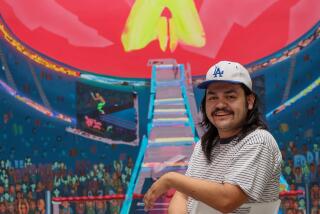‘Breaking Bad’s’ creator tried to ignore fan reactions. This epic art broke through
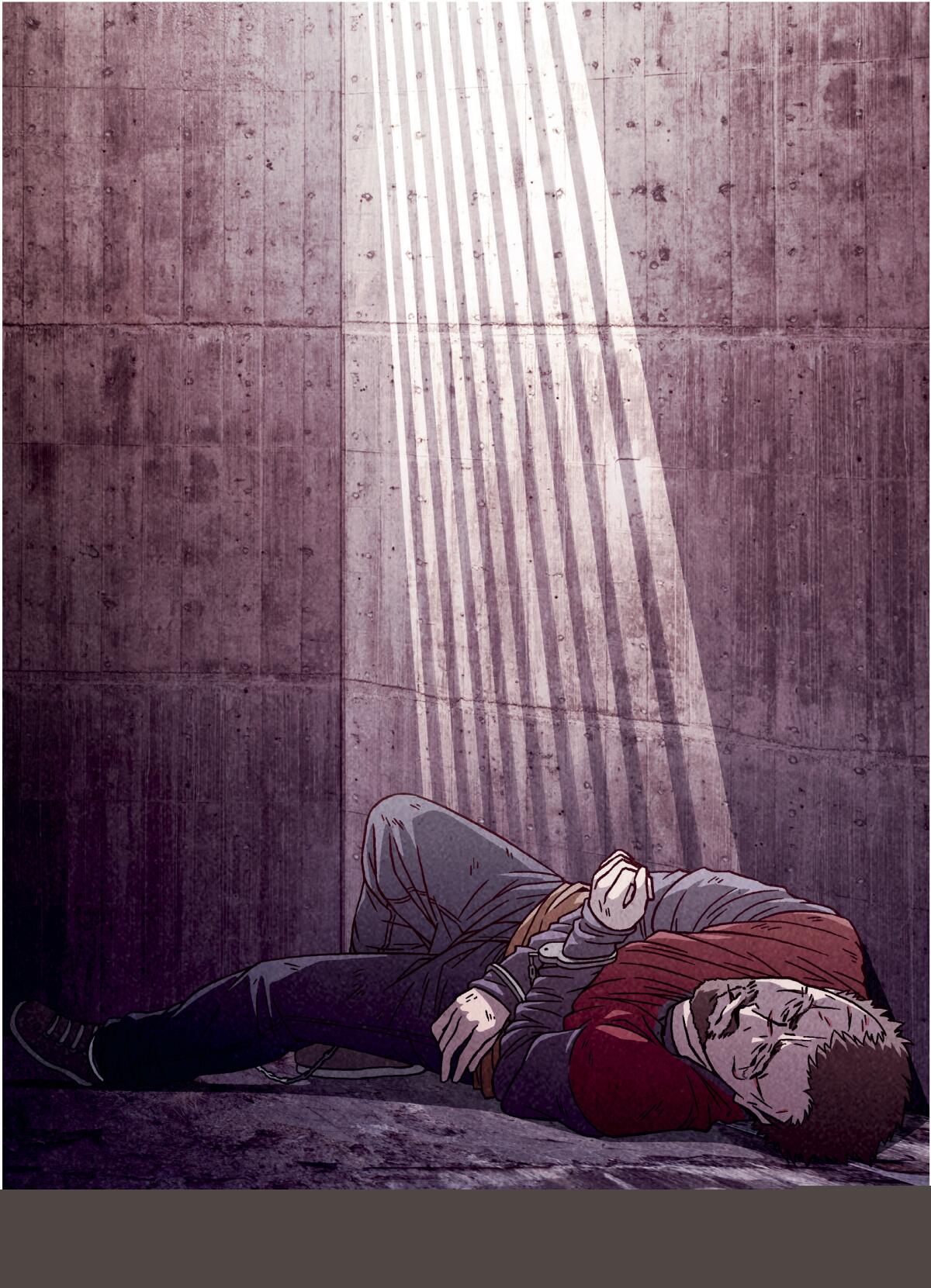
- Share via
“The colors used to be much more reserved,” Los Angeles-based artist Eugene Huang remembers. “At one point, Vince [Gilligan] asked me to, and I quote, ‘Push it until it breaks.’”
Huang is thinking back to “Study of Change,” the digital painting he created for the cover of “99.1% Pure: Breaking Bad Art,” a spiffy new book full of fan art inspired by Gilligan’s AMC series, which chronicles high-school teacher Walter White’s ill-advised foray into the meth trade. The cover design honors the opening titles of “Breaking Bad,” which repurpose the symbols for chemical elements. In Huang’s painting, “Br” and “Ba” are joined by “Ar,” for “Art.” The squares framing each letter pairing strike the eye as textured strokes of color — sinuous pools of green and amber.
Then one peers closer. Densely compacted into each square are tiny references to the events and characters of each season. “The concept for the cover is all from Vince,” Huang says. But it was he who spent hours realizing the idea, a task he found singularly absorbing: “The only reason I had to force myself to stop was the fact that we were already well past the deadline for the illustration.” Huang, who contributed two other pieces to the book, looks back on the experience with gratitude.
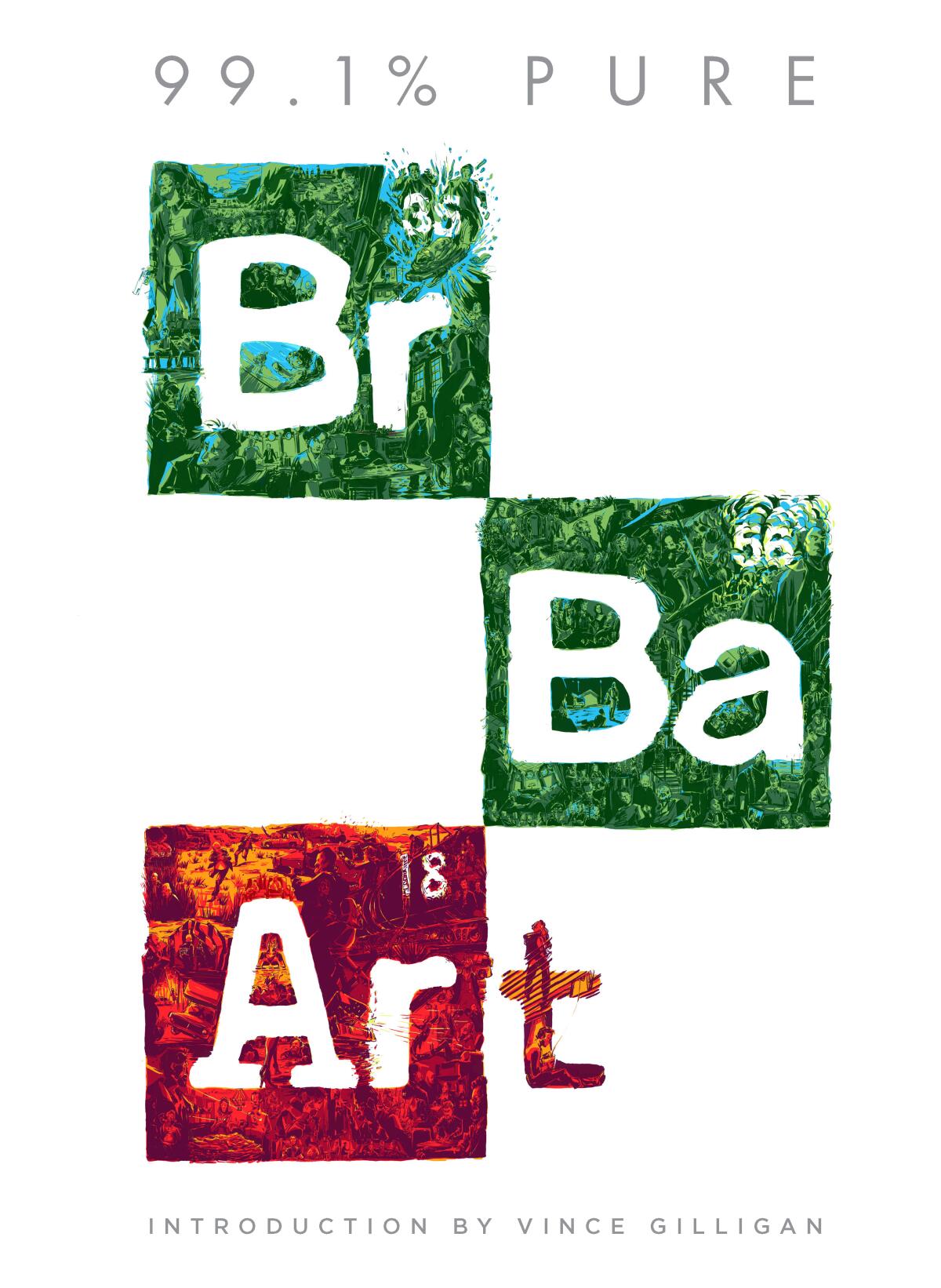
Evidently, the gratitude extends both ways. Gilligan’s introduction frames “99.1% Pure” as a form of recognition for the show’s global cohort of fan artists. “We wanted to celebrate these fans,” Gilligan told The Times. “It just blew my mind when I really started to understand the depth and breadth of [their art].” Gilligan, who often fastidiously acknowledges the efforts of his collaborators, extends a similar courtesy to the many artists who weren’t incorporated into the book’s 232 pages. “99.1% Pure” is ”a representative swath,” he says. “[There’s] much more talent out there in the world that we unfortunately weren’t able to fit in this book.”
Text by authors Claudia Azurmendi and Joanna Zhang accompanies art curated by Gilligan and several of his colleagues from the production of “Breaking Bad” and its spinoff, “Better Call Saul”: Jenn Carroll, Clementine Dunnell, Melissa Ng and Melissa Bernstein. Carroll, a producer on “Better Call Saul,” was also among the first to alert Gilligan to the fan art, printouts of which now adorn the “Better Call Saul” writers offices. Though Gilligan prefers to protect his creative process by avoiding the online reactions to his work, he found himself literally surrounded by the artistic statements of fans. “And all of it to a fantastic degree of artistry,” he marvels. “It breached my […] firewall, so to speak, and it led to the idea of this art book.”
Of course, long before the publication of “99.1% Pure,” fan artists had enjoyed online recognition of their work. “My ‘viral’ illustrations helped me gain confidence in my talent,” says Constance Harvey, an artist based in Montréal, whose caricature of Gilligan accompanies the book’s introduction. “Having Vince Gilligan [mention] that ‘talented young lady’ in a podcast when you know he’s literally talking about yourself is an incredible confidence boost.”
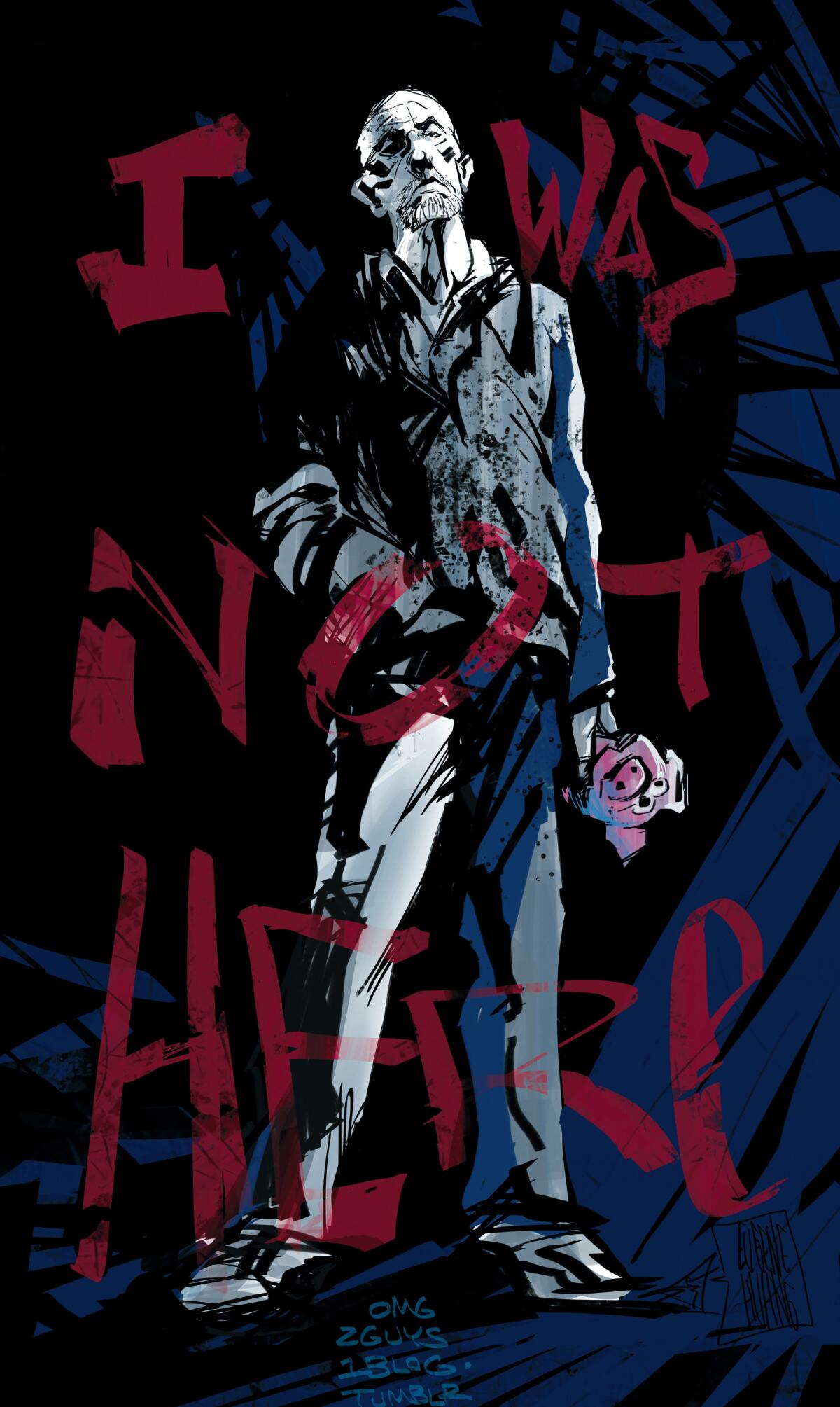
Chicago’s Beth Evans is similarly appreciative: “‘Breaking Bad’ [fan art] was such a launching platform for me. It was one of the first things that got me noticed online.” And for Jake Giddens of Portland, Ore., there’s a convivial quality to fan art, a sense of fellowship. “[It’s] about connection,” he says. “Connection to the stories and connecting with other fans who love the same thing you do.”
“99.1% Pure” reinforces those connections, and it narrows the gap between the show’s creators and fan artists. Carlos Valarezo, from Loja, Ecuador, fondly recalls being invited to contribute to the book. “I was very excited,” he says. “First, because Jenn Carroll herself emailed me, and then because Vince Gilligan had seen and liked my piece.” That piece — the ink and digital painting “The Destruction of the Superlab” — was inspired by the Season 4 finale, “Face Off,” in which Walter and apprentice Jesse Pinkman endeavor to detonate a subterranean meth lab. The actual scene is celebratory and chaotic, its action paired with the high-wire strumming of the Taalbi Brothers’ song “Freestyle.” Valarezo listened to the song on repeat; it energized his line work. Those tones of celebration and chaos are skillfully reconfigured in his painting: The laboratory’s flames here achieve the delicacy of snowfall or confetti.
Tokyo’s Mariko Kumano instead found inspiration in the art of Jane Margolis, Jesse’s girlfriend from the second season. In the episode “Over,” Jane reconciles with Jesse by gifting him a self-portrait in which she’s depicted as a superhero named “Apology Girl.” Kumano’s own version, “Apology Girl / Gomenne Girl,” reimagines that sketch, introducing a dazzle of pencil and watercolor textures. The interior of Apology Girl’s cape is a cosmic vista (“This is my favorite aspect,” Kumano says), the hair newly buoyant and windswept, and the eyes more animated and expressive. “I felt sympathy with [Jane],” Kumano says, “as she is an artistic person, like me. [...] I thought it would be like a chemical reaction when I combined her style with mine.”
The complete guide to home viewing
Get Screen Gab for everything about the TV shows and streaming movies everyone’s talking about.
You may occasionally receive promotional content from the Los Angeles Times.
Many such “chemical reactions” explode across the book. For all its levity, “Breaking Bad” is fundamentally grim, tethered as it is to Walter White’s ballooning ego, but a number of these artists manage to escape that megalomaniacal shadow, embracing the offbeat or irreverent instead. Rome’s Francesca Zingaretti, who uses the professional name Ceci N’Est Pas Francesca, borrowed from René Magritte’s “The Son of Man” for her crayon and Ecoline piece “Breaking Bad — The Son of Heisenberg,” in which Walter’s glare is impishly plastered over by a Los Pollos Hermanos cup. Other pieces are stranger still — one finds characters literally painted onto skateboards, Pez dispensers and matryoshka dolls.
Gilligan is gratified by the playfulness. “If this were just flat-out hagiography toward, say, Walter White […] if I saw page after page of that, I think I’d find it disturbing,” he reflects. “I think of the show in kind of dark terms because of the story material and because I recall how hard it was to make. But then I look through this book and there’s little […] versions of Walt and Jesse that look like they’re made out of plastic building blocks. […] There’s such joy in some of these renderings.”
This accords with the view of Angeleno Pana Stamos. “I really pulled this show apart to examine it in painstaking detail,” she says. “But that’s the joy of derivative work: immersing yourself in a world and filling in the missing pieces.” Stamos’ digital painting “Protect This Family” is a low-angle depiction of Skyler White raising a butcher knife, her gaze steely-eyed and shadow-strewn. It’s a stylized variation on a scene from “Ozymandias,” in which Skyler squares off against her husband, Walter. “I wanted to return to [Skyler] some of the power that had been taken from her,” Stamos says. “That [scene] truly was a heroic moment for her. An underappreciated one.”
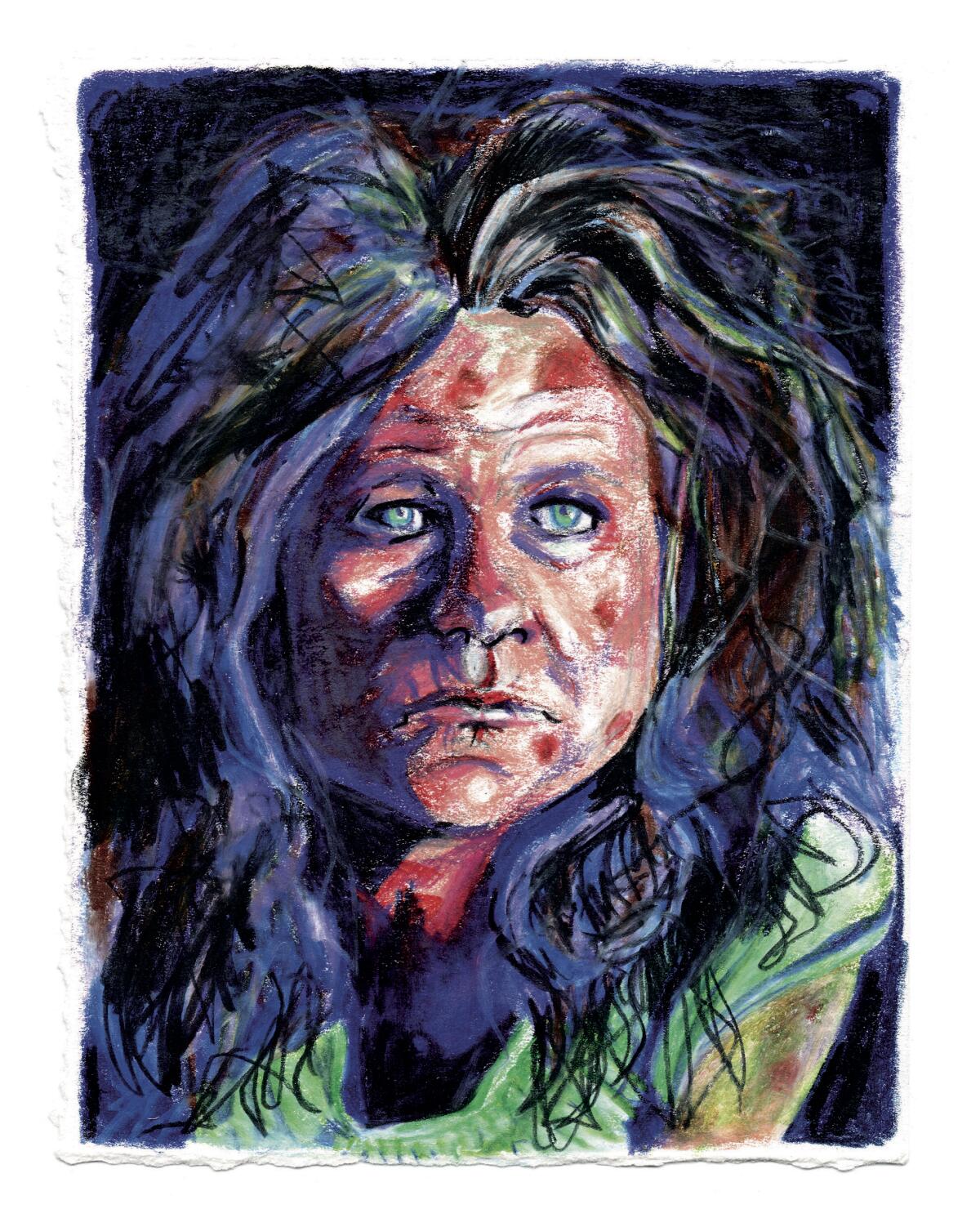
Other artists reappraise minor characters, retrieving them from the show’s fringes and granting them new prominence. In “Ain’t No Skank,” Brittany Busch, of Amarillo, Texas, confects a colored-pencil portrait of Spooge’s Woman, Dale Dickey’s meth-addicted character from the episodes “Breakage” and “Peekaboo.” Busch was struck by Dickey’s screen presence: “I [couldn’t] help but notice the soft skin around the sores, [and] the wide, icy blue eyes, and the fear, longing and sadness that fills them. […] I found beauty in that.”
Yang Kwang Tatt, from Kuala Lumpur, Malaysia, is likewise fascinated by, as he puts it, “very minor details and changes.” His digital portrait, “My Baby Blue Series: Jesse,” takes as its subject one poignant glance from Jesse in the episode “Hazard Pay.” In its original context, the glance is a reaction to Walter’s latest bit of manipulative patter. But in Yang’s piece, the reaction itself is the focus; it’s faithfully represented and made conspicuous against gentle shades of blue and lavender.
Gilligan is thrilled that certain images from “Breaking Bad” have endured in the minds of viewers and inspired such artistic scrutiny. He also understands the fascination. With respect to both cinema and television, he holds visuals in higher esteem than dialogue: “The stuff that sticks with you personally, [...] [and] has the potential to stick deeper in your subconscious, is the images.”
“99.1% Pure” has also prompted Gilligan to reflect on other kinds of enduring memories. The book recalls to him the bygone exhilarations of art class in elementary and high school, “that hour of getting to paint and draw and […] make sculptures and fire pottery and make jewelry.” As noted in his introduction, these specific artistic interests eventually dissipated, though he sees things differently now. “About ninth or 10th grade, I realized I really wasn’t that talented at it,” he says. “It’s a shame to have that competitiveness — that idea of ‘Gee, I’m not as good as I want to be’ — instead of taking the proper lesson of: ‘Keep doing it until you get better.’ And mainly do it because you enjoy it, because it fulfills some sort of need in you.”
But for Gilligan, regardless of one’s chosen medium or creative field, a distinct point of view is paramount. “I look at this book,” he says, “I look at all these artists. And they’re all very talented. And they all see the world through their own unique lens. And that’s the most important thing: […] to communicate the way you see the world through your art.”
More to Read
The complete guide to home viewing
Get Screen Gab for everything about the TV shows and streaming movies everyone’s talking about.
You may occasionally receive promotional content from the Los Angeles Times.


